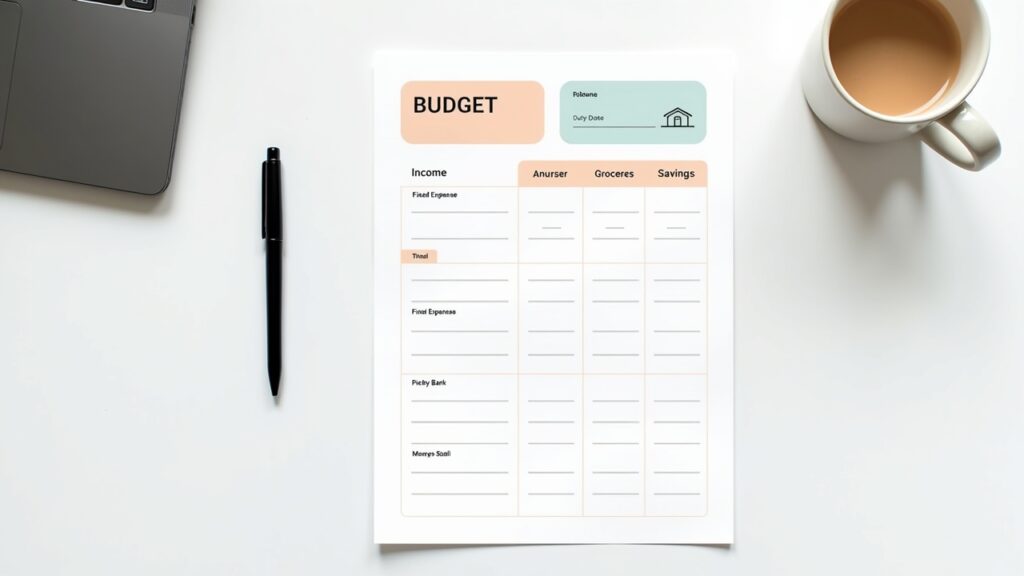Advertisements
Did you know that 78% of Americans live paycheck to paycheck? I used to be one of them until I discovered something that changed everything – minimalist budgeting. Trust me, this isn’t about eating ramen noodles every night or giving up Netflix!
I remember sitting at my kitchen table, surrounded by credit card statements and feeling totally overwhelmed. My Excel spreadsheet had like 47 categories (yes, I counted), and I was tracking every single penny. It was exhausting. That’s when I realized I needed a simpler approach to managing my finances.
Minimalist budgeting saved my sanity and my savings account. And I’m gonna show you exactly how to do it too.
What Even Is Minimalist Budgeting?

Okay, so minimalist budgeting is basically the Marie Kondo approach to your finances. You keep only what truly matters and ditch the rest. No more tracking if you spent $3.47 or $3.52 on that latte.
The core principle is simple: focus on the big picture instead of getting lost in the details. I learned this the hard way after spending hours categorizing expenses that didn’t really impact my financial goals. Now I use what’s called the 50/30/20 rule as my foundation.
Here’s what makes minimalist budgeting different from traditional budgeting methods:
- Fewer categories (I went from 47 to just 3!)
- Less time tracking (maybe 10 minutes a week)
- Focus on automation
- Emphasis on values over vanity metrics
Setting Up Your Simple Budget System
When I first started, I thought I needed fancy apps and complicated spreadsheets. Nope! All you really need is a basic understanding of your income and three main buckets for your money.
First, figure out your after-tax income. This one tripped me up initially because I was counting my gross pay. Then divide your money into these categories: needs (50%), wants (30%), and savings/debt (20%). That’s literally it.
Your “needs” bucket covers rent, utilities, groceries – the boring stuff that keeps you alive. The “wants” category is for fun money (yes, you’re allowed to have fun!). And that last bucket? That’s where the magic happens for your future self.
The Tools That Actually Work
I’ve tried everything from Mint to YNAB to good old pen and paper. Here’s what actually stuck for me: a simple checking account for bills, a separate one for spending money, and automatic transfers. Revolutionary, right?
The game-changer was setting up automatic transfers right after payday. Money for bills goes to one account, savings gets whisked away before I can touch it, and what’s left is guilt-free spending money. No spreadsheets required.
Some people love apps like YNAB for zero-based budgeting, but honestly? It felt like too much work for my lazy brain. The best system is the one you’ll actually use.
Common Mistakes I Made (So You Don’t Have To)
Oh boy, where do I start? My biggest mistake was trying to go from financial chaos to perfection overnight. I set up this super restrictive budget that allowed $50 a month for “fun” – yeah, that lasted about three days.
Another goof-up was not accounting for irregular expenses. You know, those sneaky annual fees or quarterly insurance payments that somehow always surprise you? Now I just add 10% to my needs category as a buffer. Problem solved.
The worst mistake though? Not automating anything. I’d forget to transfer money to savings, then feel guilty, then give up entirely. It was a vicious cycle that kept me broke and stressed.
Real Results From Real People (Including Me!)

After six months of minimalist budgeting, I had saved my first $1,000 emergency fund. Me! The person who once overdrafted buying a sandwich! Within a year, I’d paid off two credit cards and actually enjoyed a vacation without guilt.
My friend Sarah tried this approach too. She went from checking her bank balance with dread to having three months of expenses saved. Her secret? She only looks at her finances once a week now instead of obsessing daily.
The mental clarity is honestly the best part. When you’re not constantly stressed about money, you can focus on stuff that actually matters. Like, I don’t know, living your life?
Making Minimalist Budgeting Work For Your Life
Look, this isn’t a one-size-fits-all thing. Maybe you need four categories instead of three. Maybe you prefer weekly check-ins instead of monthly. The point is to find what works for you and stick with it.
Start small. Pick one thing to automate this week. Maybe it’s just your savings transfer, or setting up a bill pay. Build from there. Rome wasn’t built in a day, and neither is financial peace of mind.
Remember, the goal isn’t perfection – it’s progress. Some months you’ll nail it, others you’ll blow your budget on takeout. That’s totally normal and okay. The minimalist approach means you can get back on track without drowning in complicated spreadsheets.
Ready to simplify your financial life? Start with one small change today. And if you want more tips on living with less stress and more cash flow, check out other posts on Cashflow Zen. We’re all about making money management actually manageable!




[…] than end up in the emergency room. Want more money-saving tips for homeowners? Check out other practical guides at Cashflow Zen – we’re all about keeping more cash in your […]